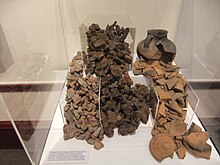
Briquetage or very coarse pottery (VCP) is a coarse ceramic material used to make evaporation vessels and supporting pillars used in extracting salt from brine or seawater. Thick-walled saltpans were filled with saltwater and heated from below until the water had boiled away and salt was left behind. Often, the bulk of the water would be allowed to evaporate in salterns before the concentrated brine was transferred to a smaller briquetage vessel for final reduction. Once only salt was left, the briquetage vessels would have to be broken to remove the valuable commodity for trade.
Broken briquetage material is found at multiple sites from the later Bronze Age in Europe into the medieval period and archaeologists have been able to identify different forms and fabrics of the pottery, allowing trade networks to be identified. Saltworking sites contain large quantities of the orange/red material and in Essex the mounds of briquetage are known as Red Hills. A recent discovery at the Poiana Slatinei archaeological site next to a salt spring in Lunca, Neamt County, Romania, indicates that Neolithic people of the Precucuteni Culture were boiling the salt-laden spring water through the process of briquetage to extract the salt as far back as 6050 BC, making it perhaps the oldest saltworks in history.
References
- "Briquetage". Oxford Reference. Retrieved 24 March 2021.
- Harding, Anthony: Salt in Prehistoric Europe. Leiden: Sidestone Press, 2013, ISBN 978-90-8890-201-7, pp. 73 ff.
- Lane & Morris (2001) A Millennium of Saltmaking: Prehistoric and Romano-British Salt Production in the Fenland
- "Antiquity, Project Gallery: Weller & Dumitroaia". Archived from the original on 30 April 2011. Retrieved 12 October 2012. Antiquity Vol 79 No 306 December 2005 The earliest salt production in the world: an early Neolithic exploitation in Poiana Slatinei-Lunca, Romania Olivier Weller & Gheorghe Dumitroaia
- "Sarea, Timpul şi Omul". Archived from the original on 21 February 2009. Retrieved 17 January 2010. Valeriu Cavruc Gheorghe Dumitroaia Vestigii arheologice privind exploatarea sãrii pe teritoriul României în perioada neo-eneoliticã
This material-related article is a stub. You can help Misplaced Pages by expanding it. |
This article relating to archaeology in Europe is a stub. You can help Misplaced Pages by expanding it. |